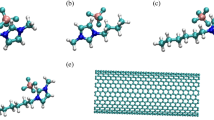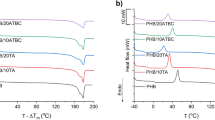Abstract
A molecular dynamics simulation is employed to investigate the effects of nano-SiO2 particles on the properties of polyvinyl alcohol (PVA)/poly(vinyl pyrrolidone) (PVP) blends and demonstrate the interaction mechanism of nano-SiO2 particles in blend systems. Six blend systems with different concentrations of SiO2 particles (0–12.8%) and two interfacial interaction models of polymers on the SiO2 surface were designed and analyzed in terms of density distribution, mechanical properties, fractional free volume, and X-ray diffraction patterns. The incorporation of nano-SiO2 particles into the PVA/PVP blend systems increased their mechanical properties, densities, and semicrystalline character. Density distribution analysis indicated PVA molecular chains are more easily adsorbed on the SiO2 surface than PVP molecular chains. Finally, an analysis of binding energies and pair correlation functions of interfacial interaction models revealed the interaction mechanism of nano-SiO2 particles in PVA/PVP systems. Hydrogen bond interactions between polar functional groups in polymer molecular chains and the hydroxyl groups of the SiO2 surface are involved in adsorption of the polymers on the SiO2 surface and explain why nano-SiO2 particles can significantly influence the properties of PVA/PVP systems.












Similar content being viewed by others
References
Penkova AV, Acquah SFA, Dmitrenko ME, Sokolova MP et al (2016) Improvement of pervaporation PVA membranes by the controlled incorporation of fullerenol nanoparticles. Mater Des 96:416–423
Morales-Hurtado M, Zeng X, Gonzalez-Rodriguez P, Ten Elshof JE et al (2015) A new water absorbable mechanical epidermal skin equivalent: The combination of hydrophobic PDMS and hydrophilic PVA hydrogel. J Mech Behav Biomed Mater 46:305–317
Jiang S, Liu S, Feng W (2011) PVA hydrogel properties for biomedical application. J Mech Behav Biomed Mater 4:1228–1233
Choi J, Kung HJ, Macias CE, Muratoglu OK (2012) Highly lubricious poly (vinyl alcohol)-poly (acrylic acid) hydrogels. J Biomed Mater Res B Appl Biomater 100(2):524–532
Biswas A, Willet JL, Gordon SH, Finkenstadt VL et al (2006) Complexation and blending of starch, poly(acrylic acid), and poly(N-vinyl pyrrolidone). Carbohydr Polym 65:397–403
Ma R, Xiong D, Miao F, Zhang J (2009) Novel PVP/PVA hydrogels for articular cartilage replacement. Mater Sci Eng C 29:1979–1983
Shi Y, Xiong D, Liu Y, Wang N et al (2016) Swelling, mechanical and friction properties of PVA/PVP hydrogels after swelling in osmotic pressure solution. Mater Sci Eng C Mater Biol Appl 65:172–780
Wei Q, Zhang Y, Wang Y, Chai W et al (2016) Measurement and modeling of the effect of composition ratios on the properties of poly(vinyl alcohol)/poly(vinyl pyrrolidone) membranes. Mater Des 103:249–258
Leone G, Consumi M, Greco G, Bonechi C et al (2011) A PVA/PVP hydrogel for human lens substitution: synthesis, rheological characterization, and in vitro biocompatibility. J Biomed Mater Res Part B Appl Biomater 97B:278–288
Shi Y, Xiong D, Zhang J (2014) Effect of irradiation dose on mechanical and biotribological properties of PVA/PVP hydrogels as articular cartilage. Tribol Int 78:60–67
Mallakpour S, Nouruzi N (2016) Modification of morphological, mechanical, optical and thermal properties in polycaprolactone-based nanocomposites by the incorporation of diacid-modified ZnO nanoparticles. J Mater Sci 51:6400–6410. doi:10.1007/s10853-016-9936-1
Zhao Y, Wang C (2016) Nano-network MnO2/polyaniline composites with enhanced electrochemical properties for supercapacitors. Mater Des 97:512–518
Zheng F, Wang S, Wen S, Shen M et al (2013) Characterization and antibacterial activity of amoxicillin-loaded electrospun nano-hydroxyapatite/poly(lactic-co-glycolic acid) composite nanofibers. Biomaterials 34:1402–1412
Dodda JM, Belsky P, Chmelar J, Remis T et al (2015) Comparative study of PVA/SiO2 and PVA/SiO2/glutaraldehyde (GA) nanocomposite membranes prepared by single-step solution casting method. J Mater Sci 50:6477–6490. doi:10.1007/s10853-015-9206-7
Dil Ebrahim Jalali (2015) Favis Basil D. Localization of micro and nano- silica particles in a high interfacial tension poly(lactic acid)/low density polyethylene system. Polymer 77:156–166
Yang M, Xia Y, Wang Y, Zhao X et al (2016) Preparation and property investigation of crosslinked alginate/silicon dioxide nanocomposite films. J Appl Polym Sci 133:43489
Malaki M, Hashemzadeh Y, Karevan M (2016) Effect of nano-silica on the mechanical properties of acrylic polyurethane coatings. Prog Organ Coat 101:477–485
Dil EJ, Virgilio N, Favis BD (2016) The effect of the interfacial assembly of nano-silica in poly(lactic acid)/poly(butylene adipate-co-terephthalate) blends on morphology, rheology and mechanical properties. Eur Polym J 85:635–646
Fallah S, Nematzadeh M (2017) Mechanical properties and durability of high-strength concrete containing macro-polymeric and polypropylene fibers with nano-silica and silica fume. Constr Build Mater 132:170–187
Pattnaik S, Nethala S, Tripathi A, Saravanan S et al (2011) Chitosan scaffolds containing silicon dioxide and zirconia nano particles for bone tissue engineering. Int J Biol Macromol 49:1167–1172
von Wilmowsky C, Vairaktaris E, Pohle D, Rechtenwald T et al (2008) Effects of bioactive glass and beta-TCP containing three-dimensional laser sintered polyetheretherketone composites on osteoblasts in vitro. J Biomed Mater Res 87A:896–902
Siavashani AZ, Nazarpak MH, Fayyazbakhsh F, Toliyat T et al (2016) Effect of amino-functionalization on insulin delivery and cell viability for two types of silica mesoporous structures. J Mater Sci 51:10897–10909. doi:10.1007/s10853-016-0301-1
Ghanaati SM, Thimm BW, Unger RE, Orth C et al (2010) Collagen-embedded hydroxylapatite-beta-tricalcium phosphate–silicon dioxide bone substitute granules assist rapid vascularization and promote cell growth. Biomed Mater 5:025004
Jin T, Li X, Sun H (2013) Interaction mechanisms between poly(amido-amine) and nano-silicon dioxide. Int J Quantum Chem 113:1213–1224
Zhang Z, Wang S, Zhang J, Zhu W et al (2016) Self-formation of elastomer network assisted by nano-silicon dioxide particles: a simple and efficient route toward polymer nanocomposites with simultaneous improved toughness and stiffness. Chem Eng J 285:439–448
Chrissafis K, Paraskevopoulos KM, Papageorgiou GZ, Bikiaris DN (2008) Thermal and dynamic mechanical behavior of bionanocomposites: fumed silica nanoparticles dispersed in poly(vinyl pyrrolidone), chitosan, and poly(vinyl alcohol). J Appl Polym Sci 110:1739–1749
Lu J, Liu D, Yang X, Zhao Y et al (2015) Molecular dynamics simulations of interfacial interactions between small nanoparticles during diffusion-limited aggregation. Appl Surf Sci 357:1114–1121
Roussou R-E, Karatasos K (2016) Graphene/poly(ethylene glycol) nanocomposites as studied by molecular dynamics simulations. Mater Des 97:163–174
Lai ZB, Wang M, Yan C, Oloyede A (2014) Molecular dynamics simulation of mechanical behavior of osteopontin-hydroxyapatite interfaces. J Mech Behav Biomed Mater 36:12–20
Naruke Y, Kosaka S, Nakano T, Kikugawa G et al (2015) A molecular dynamics study on mass transport characteristics in the vicinity of SiO2-water/IPA interfaces. Int J Heat Mass Transf 84:584–591
Wei Q, Wang Y, Chai W, Wang T et al (2016) Effects of composition ratio on the properties of poly(vinyl alcohol)/poly (acrylic acid) blend membrane: a molecular dynamics simulation study. Mater Des 89:848–855
Wang Y, Wei Q, Wang S, Chai W et al (2017) Structural and water diffusion of poly(acryl amide)/poly(vinyl alcohol) blend films: Experiment and molecular dynamics simulations. J Mol Graph Model 71:40–49
Wei Q, Wang Y, Che Y, Yang M et al (2017) Molecular mechanisms in compatibility and mechanical properties of polyacrylamide/polyvinyl alcohol blends. J Mech Behav Biomed Mater 65:565–573
Wang Y, Li X, Wei Q, Yang M et al (2015) Study on the mechanical properties of three-dimensional directly binding hydroxyapatite powder. Cell Biochem Biophys 72:289–295
Wei Q, Wang Y, Li X, Yang M et al (2016) Study the bonding mechanism of binders on hydroxyapatite surface and mechanical properties for 3DP fabrication bone scaffolds. J Mech Behav Biomed Mater 57:190–200
Materials Studio Version 5.5 (2010) Accelrys Inc., San Diego, CA
Sun H (1998) COMPASS: an ab initio force-field optimized for condensed-phase applications overview with details on alkane and benzene compounds. J Phys Chem B 102:7338–7364
Andersen HC (1980) Molecular dynamics simulations at constant pressure and/or temperature. J Chem Phys 72:2374–2383
Liu J, Cao D, Zhang L (2008) Molecular dynamics study on nanoparticle diffusion in polymer melts: a test of the Stokes–Einstein law. J Phys Chem C 112:6653–6661
Asghari S, Hatami M, Ahmadipour M (2015) Preparation and investigation of novel PVA/silica nanocomposites with potential application in NLO. Polym Plast Technol Eng 54:192–201
Peng FB, Jiang ZY, Hoek EMV (2011) Tuning the molecular structure, separation performance and interfacial properties of poly(vinyl alcohol)-polysulfone interfacial composite membranes. J Membr Sci 368:26–33
Jawalkar Sheet S, Aminabhavi TM (2007) Molecular dynamics simulations to compute diffusion coefficients of gases into polydimethylsiloxane and poly{(1,5-naphthalene)-co-[1,4-durene-2,2′-bis(3,4-dicarboxyl phenyl)hexafluoropropanediimide]}. Polym Int 56:928–934
Shariatinia Z, Jalali AM, Taromi FA (2016) Molecular dynamics simulations on desulfurization of n-octane/thiophene mixture using silica filled polydimethylsiloxane nanocomposite membranes. Modell Simul Mater Sci Eng 24:035002
Abdelrazek EM, Elashmawi IS, Labeeb S (2010) Chitosan filler effects on the experimental characterization, spectroscopic investigation and thermal studies of PVA/PVP blend films. Phys B 405:2021–2027
Xiang Y, Liu Y, Mi B, Leng Y (2014) Molecular dynamics simulations of polyamide membrane, calcium alginate gel, and their interactions in aqueous solution. Langmuir 30:9098–9106
Acknowledgements
This project was sponsored by the China Scholarship Council (CSC, 201606290095), the National Natural Science Foundation of China, (Grant No. 51175432), the Fundamental Research Funds for the Central Universities (Grant No. 3102014JCS05007), the key Industrial Science and technology projects of Shaanxi (Grant No. 2015GY047).
Author information
Authors and Affiliations
Corresponding author
Ethics declarations
Conflict of interest
The authors declare that they have no conflict of interest.
Rights and permissions
About this article
Cite this article
Wei, Q., Zhang, Y., Wang, Y. et al. A molecular dynamic simulation method to elucidate the interaction mechanism of nano-SiO2 in polymer blends. J Mater Sci 52, 12889–12901 (2017). https://doi.org/10.1007/s10853-017-1330-0
Received:
Accepted:
Published:
Issue Date:
DOI: https://doi.org/10.1007/s10853-017-1330-0




